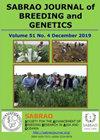HYDROGENATION TECHNOLOGY AND CHEMISTRY OF COTTONSEED OIL AND FATS
IF 1.7
Q3 PLANT SCIENCES
引用次数: 0
Abstract
The presented research describes the hydrogenation technology and the chemistry of vegetable oils and fats using powder and stationary catalysts. The hydrogenation technology process includes various equipment and materials, i.e., equipment for hydrogenation, laboratory flow reactor, autoclave for hydrogenation on powder nickel-copper catalyst, hydrogenation catalysts, and selection of alloy stationary catalysts and their structure. The hydrogenation process includes selecting alloy nickelaluminum catalyst promoters, measuring the viscosity of hydrogenated fat, using static catalysts as forcontacts, kinetic regularities of cotton oil hydrogenation with new modifications of nickel-copperaluminum alloy promoted catalysts, and reception of food hydrogenated fat by consecutive hydrogenation of cotton oil on powder and stationary catalysts. Modifying immobile nickel-copperaluminum alloy catalysts also evolved with the addition of vanadium, rhodium, and palladium in the hydrogenation process. The cotton oil pre-contact hydrogenation on stationary and powder nickelcopper catalysts is a novel development. It ensures an increase in the physiological and nutritional value of margarine products based on hydrogenated food fat. Studying the influence of technological regimes of cotton oil hydrogenation on new modifications of stationary nickel-copper-aluminum promoted catalysts commenced. The obtained results established the technological parameters for acquiring food and confectionery salons by combining stationary and suspended catalysts. Likewise, a combination of stationary and suspended catalysts has instituted the industrial parameters for the production of food and confectionery salons based on the effects of technological regimes (temperature, pressure, oil, and hydrogen supply rates) of cottonseed oil hydrogenation on new modifications of stationary nickel-copper-aluminum promoted catalysts.棉籽油和脂肪的加氢工艺与化学
本研究描述了使用粉末和固定催化剂的植物油和脂肪的加氢技术和化学。加氢技术过程包括各种设备和材料,即加氢设备、实验室流动反应器、粉末镍铜催化剂加氢高压釜、加氢催化剂、合金固定催化剂的选择及其结构。加氢过程包括选择合金镍铝催化剂促进剂,测量加氢脂肪的粘度,以静态催化剂为对照,镍铜铝合金催化剂的新改性对棉油加氢的动力学规律,以及通过棉花油在粉末和固定催化剂上的连续氢化来接收食品氢化脂肪。在加氢过程中,随着钒、铑和钯的加入,改性固定的镍-铜-铝合金催化剂也发生了变化。棉油在固定和粉末镍铜催化剂上的预接触加氢是一个新的发展。它确保了以氢化食品脂肪为基础的人造黄油产品的生理和营养价值的提高。研究了棉油加氢工艺条件对固定化镍-铜-铝助催化剂新改性的影响。所获得的结果确定了通过结合固定和悬浮催化剂获得食品和糖果沙龙的技术参数。同样,基于棉籽油加氢的工艺制度(温度、压力、油和氢气供应速率)对固定镍-铜-铝促进催化剂的新改性的影响,固定催化剂和悬浮催化剂的组合已经建立了用于生产食品和糖果沙龙的工业参数。
本文章由计算机程序翻译,如有差异,请以英文原文为准。
求助全文
约1分钟内获得全文
求助全文
来源期刊

Sabrao Journal of Breeding and Genetics
农林科学-奶制品与动物科学
CiteScore
1.90
自引率
50.00%
发文量
63
期刊介绍:
The SABRAO Journal of Breeding and Genetics is an international journal of plant breeding and genetics research and was first published in 1969. It is the official publication of the Society for the Advancement of Breeding Research in Asia and Oceania (SABRAO).
Its objectives are to: promote the international exchange of research information on plant breeding and genetics, by describing new research findings, or ideas of a basic or practical nature; and be a medium for the exchange of ideas and news regarding members of the Society.
The Journal gives priority to articles that are of direct relevance to plant breeders and with emphasis on the Asian region. Invited for publication are research articles, short communications, methods, reviews, commentaries, and opinion articles. Scientific contributions are refereed and edited to international standards.
The journal publishes articles for SABRAO members mainly. The Journal preferred strongly that at least one author should be a current member of the Society. Non-members may also publish in the journal.
 求助内容:
求助内容: 应助结果提醒方式:
应助结果提醒方式:


